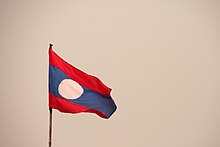Pheng Xat Lao
| English: National Anthem of Laos | |
|---|---|
 | |
National anthem of | |
| Lyrics | Sisana Sisane, 1975 |
| Music | Thongdy Sounthonevichit, 1941 |
| Adopted | 1945 |
| Audio sample | |
National Anthem of Laos (Instrumental) | |
"Pheng Xat Lao" (Template:Lang-lo; lit. English: Hymn of the Lao People) is the national anthem of the Lao People's Democratic Republic. Dr. Thongdy Sounthonevichit composed the music and wrote the lyrics in 1941. This was adopted as the national anthem of the Kingdom of Laos in 1945. The original lyrics were revised after the Pathet Lao won the Laotian Civil War and the Lao People's Democratic Republic was established in 1975, with the new lyrics written by Sisana Sisane.[1]
Official lyrics & Recognized Lyrics
| Official Lao | Latin transcription | English translation |
| Lao PDR
ຊາດລາວຕັ້ງແຕ່ໃດມາ |
Xat Lao tang tè dai ma |
For all time the Lao people |
History
In 1893, Laos became a protectorate of France within its colonial empire. The French claimed their takeover was intended to protect Laos from its hostile neighbours like Siam, which was forced to cede Laos to the colonial power. Consequently, nationalistic sentiment did not develop as quickly as it did in Vietnam. However, the outbreak of the Second World War saw the fall of France to Nazi Germany. The new right-wing government in Siam saw this as an opportunity to reconquer Laos. To counteract this, the French actively promoted nationalism among the Lao people.[3]
As a direct result of this new liberalization, many patriotic songs were composed during this time.[4] "Pheng Xat Lao" was one of them, having been composed by Dr. Thongdy Sounthonevichit in 1941.[5] The song was chosen as the national anthem of Laos in 1945,[1] when the king was forced by the Japanese to declare Laos' independence from France. This newfound freedom was short-lived as France soon regained control of French Indochina.[3] Two years later, the French granted Laos limited autonomy within the French Union and "Pheng Xat Lao" once again became the national anthem.[6]
When the Pathet Lao emerged victorious in the Laotian Civil War in 1975, the Communist government decided to change the lyrics to the anthem in order to reflect the ideology of the new regime.[7] As a result, the anthem became all-encompassing in mentioning all ethnic groups in Laos, instead of focussing solely on the Lao race and Buddhism. However, the music from the former anthem was retained.[8]
Original lyrics used in 1947
| Lao Language | Latin transcription | English translation (Literal) | English translation (singable) |
|---|---|---|---|
|
ຊາດລາວຕັ້ງແຕ່ເດີມມາ |
Xat Lao thung thae derm ma, |
Lao Nation for ever have been Once our Laotian race in Asia highly honored stood |
References
- ^ a b "Laos". The World Factbook. CIA. Retrieved May 9, 2013.
- ^ juggapud (Imperialism) specific as France and America
- ^ a b "History of Laos". Lonely Planet. Retrieved May 8, 2013.
- ^ Raffin, Anne (2005). Youth Mobilization in Vichy Indochina and Its Legacies: 1940 to 1970. Lexington Books. pp. 137–38. Retrieved May 9, 2013.
- ^ Doedan, Matt (2007). Laos in Pictures. Twenty-First Century Books. p. 69. Retrieved May 9, 2013.
- ^ Kutler, Stanley I., ed. (1996). "Laos". Encyclopedia of the Vietnam War. New York: Charles Scribner's Sons. Retrieved May 9, 2013. (subscription required)
- ^ Holt, John Clifford (2009). Spirits of the place: Buddhism and Lao religious culture. University of Hawaii Press. p. 133. Retrieved May 9, 2013.
- ^ St. John, Ronald Bruce (January 11, 2013). Revolution, Reform and Regionalism in Southeast Asia: Cambodia, Laos and Vietnam. Routledge. Retrieved May 9, 2013.
External links
- A video of "Pheng Xat Lao", broadcast on Lao National Television (LNTV) on YouTube
- A recording of "Pheng Xat Lao"'s pre-communist version on YouTube
- Michael Sauser and Gilbert Greeve - Sauser and Greeve sing the anthem on their CD "Hymnen der Welt: Asien"
- "Pheng Xat Lao" at empas.com
- Dookola Swiata - This travel website has an instrumental version of the Anthem, as an .asx file.

